![]()

Big Parade, The (1925)
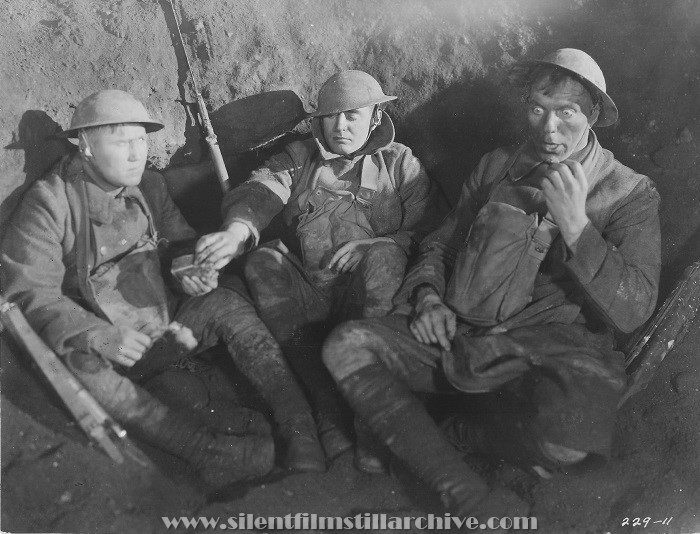
229-11 Tom O'Brien, John Gilbert and Karl Dane
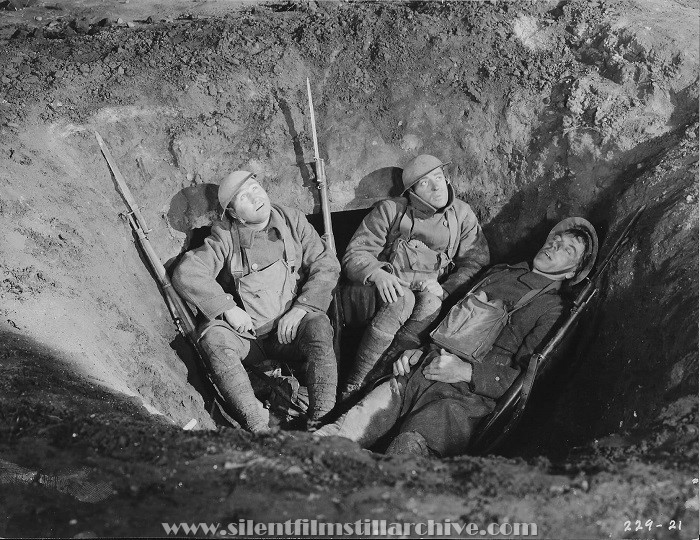
229-21 Tom O'Brien, John Gilbert and Karl Dane
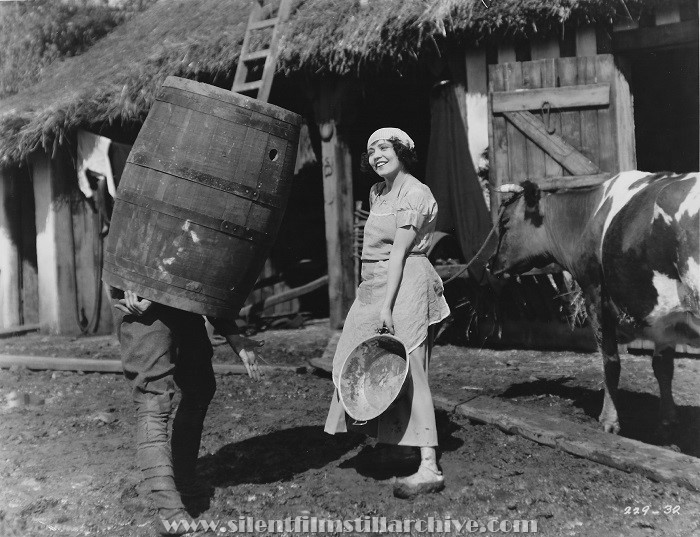
229-32 John Gilbert (inside barrel) and Renée Adorée
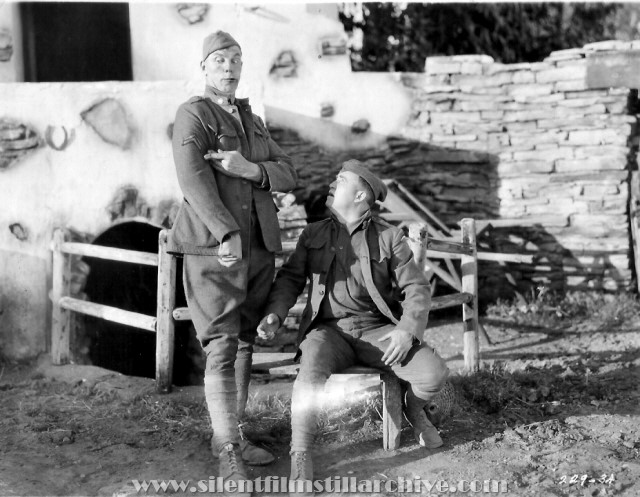
229-34 Karl Dane and Tom O'Brien
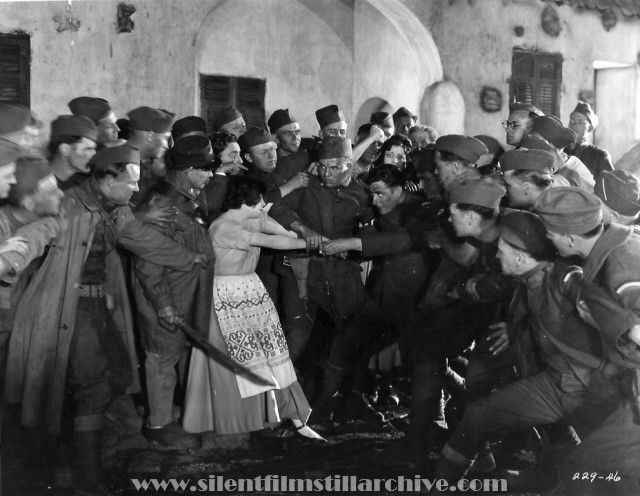
229-46 Caption: Renee Adoree and John Gilbert in a scene from "The Big Parade" directed by King Vidor for Metro-Goldwyn-Mayer.
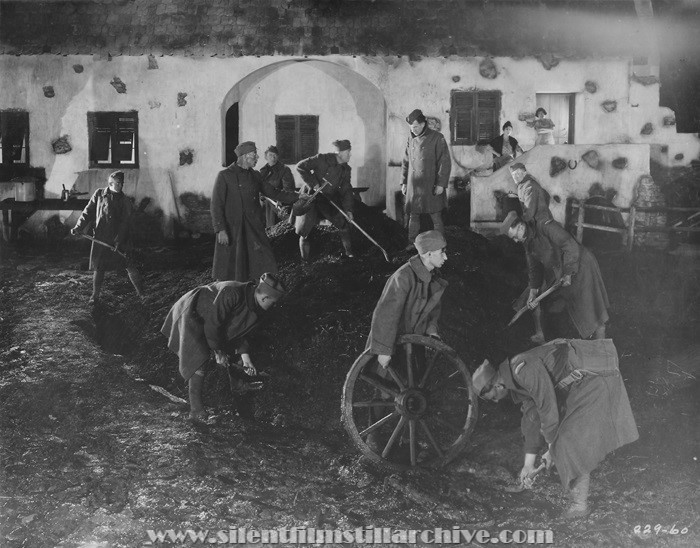
229-60 On the dirt pile: Karl Dane, Tom O'Brien, and John Gilbert
At door:
Rosita Marstini and Renée Adorée
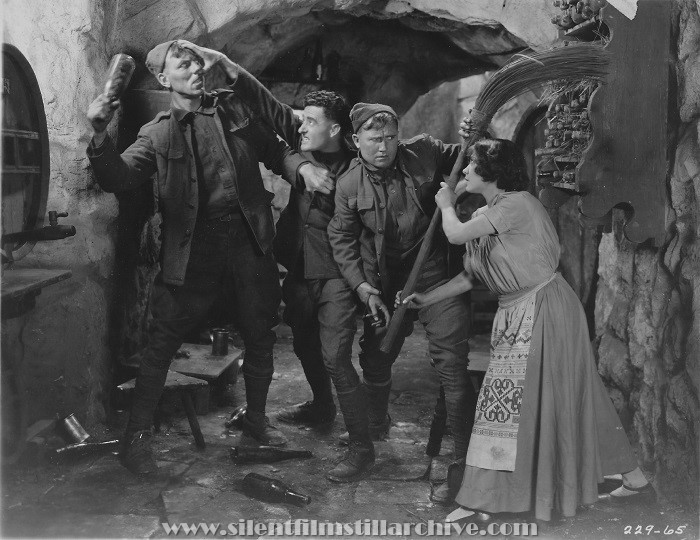
229-65 Karl Dane, John Gilbert, Tom O'Brien, and Renée Adorée
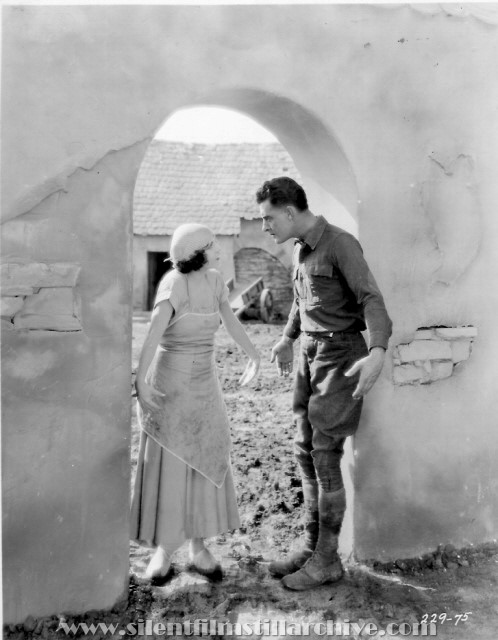
229-75 Renée Adorée, John Gilbert
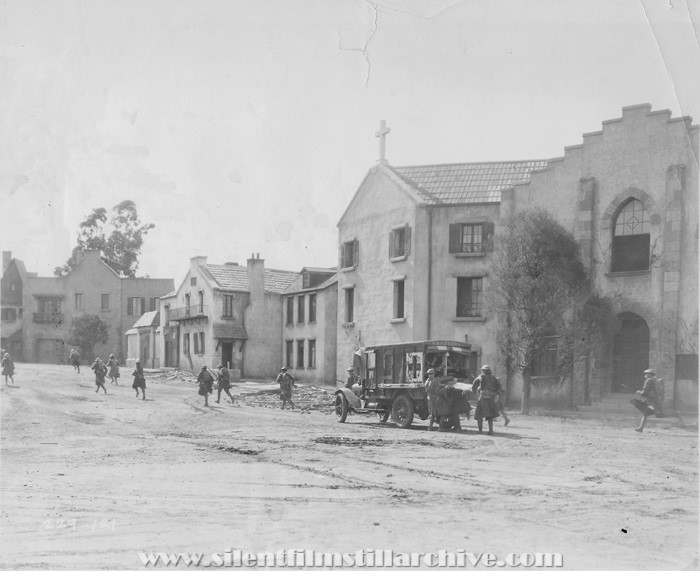
229-121
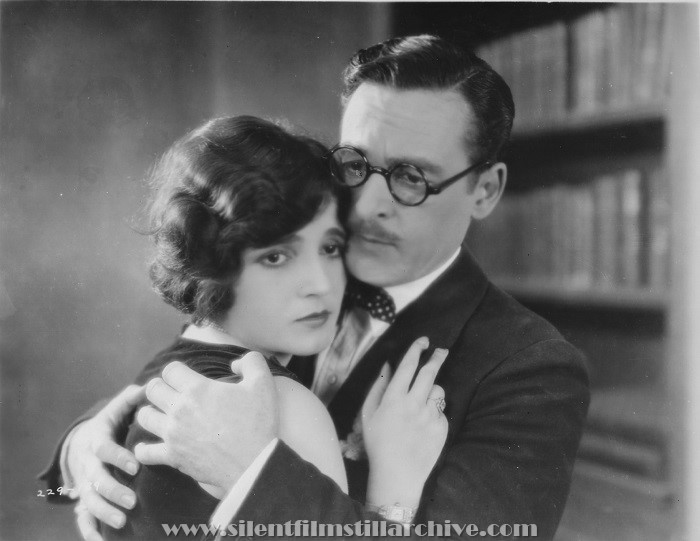
229-139 Claire Adams and Robert Ober
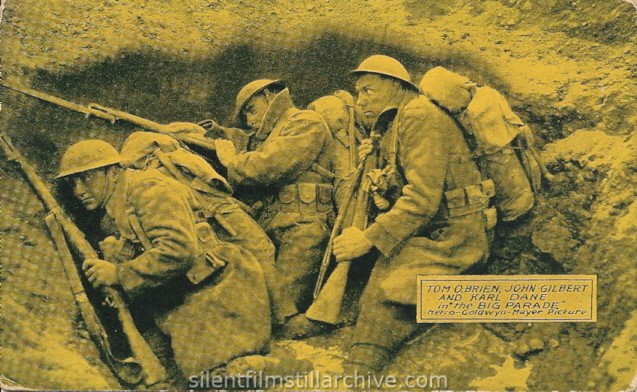
Tom O'Brien, John Gilbert and Karl Dane in "THE BIG PARADE"
Metro-Goldwyn-Mayer Picture
postcard
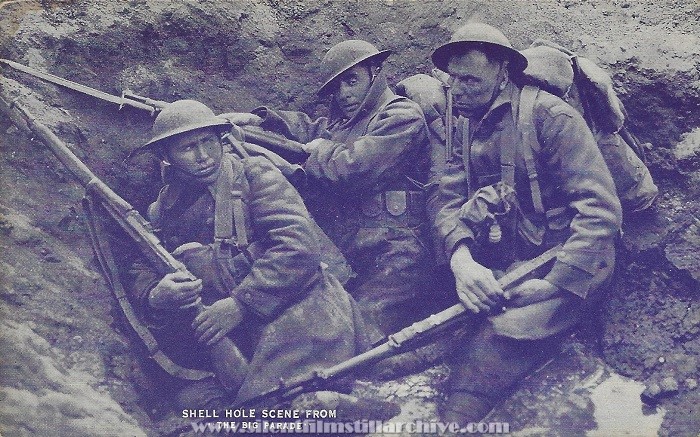
Shell Hole Scene from "The Big Parade"
arcade card
Tom O'Brien,
John Gilbert and Karl Dane
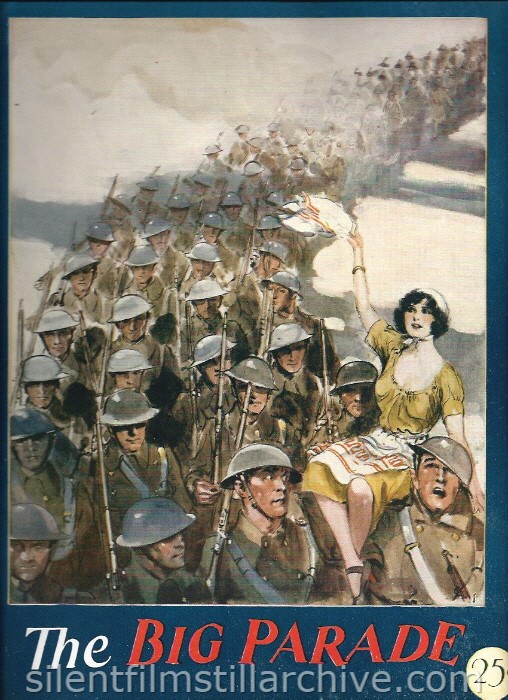
The BIG PARADE
25¢
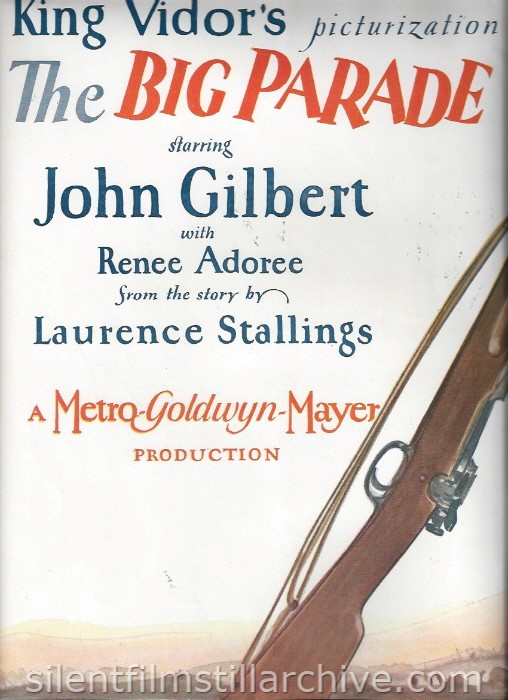
King Vidor's picturization
The BIG PARADE
starring
John Gilbert
with Renee Adoree
from the story by
Laurence Stallings
A Metro-Goldwyn-Mayer
PRODUCTION
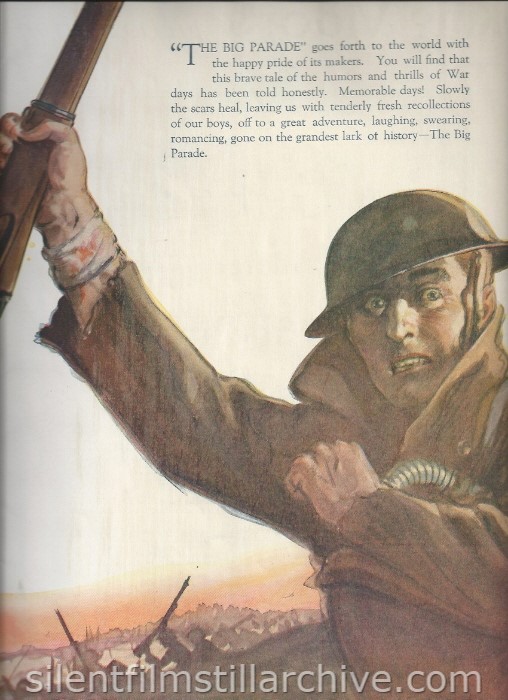
"THE BIG PARADE" goes forth to the world with the happy pride of its makers. You will find that this brave tale of the humors and thrills of War days has been told honestly. Memorable days! Slowly the scars heal, leaving us with tenderly fresh recollections of our boys, off to a great adventure, laughing, swearing, romancing, gone on the grandest lark of history -- The Big Parade.
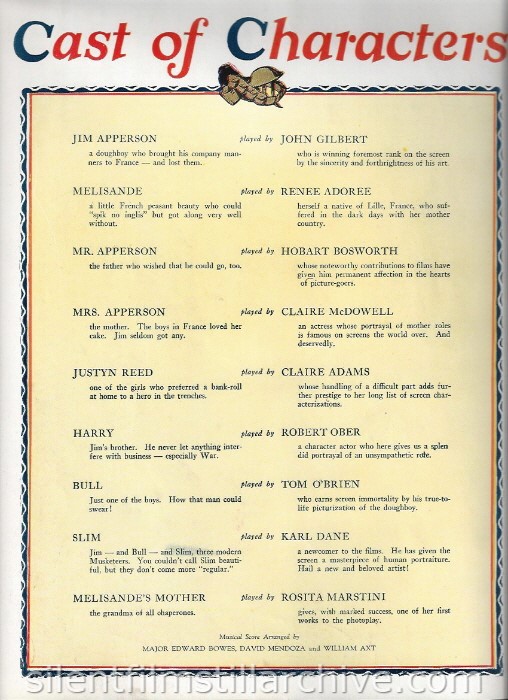
Cast of Characters
|
JIM APPERSON, a doughboy who brought his company manner to France -- and lost them. |
played by JOHN GILBERT, who is winning foremost rank on the screen by the sincerity and forthrightness of his art. |
|
MELISANDE, a little Franch peasant beauty who could "spik no inglis" but got along very well without. |
played by RENEE ADOREE, herself a native of Lille, France, who suffered in the dark days with her mother country. |
|
MR. APPERSON, the father who wished that he could go, too. |
played by Hobart Bosworth, whose noteworth contributions to films have given him permanent affection in the hearts of picture-goers. |
|
MRS. APPERSON, the mother. The boys in France loved her cake. Jim seldom got any. |
played by CLAIRE McDOWELL, an actress whose protrayal of mother roles is famous on screens the world over. And deservedly. |
|
JUSTYN REED, one of the girls who preferred a bank-roll at home to a hero in the trenches. |
played by CLAIRE ADAMS, whose handling of a difficult part adds further prestige to her long list of screen characterizations. |
|
HARRY, Jim's brother. He never let anything interfere with business -- especially War. |
played by ROBERT OBER, a character actor who here gives us a splendid portrayal of an unsympathetic role. |
|
BULL, Just one of the boys. How that man could swear! |
played by TOM O'BRIEN, who earns screen immortality by his true-to-life picturization of the doughboy. |
|
SLIM, Jim -- and Bull -- and Slim, three modern Musketeers. You couldn't call Slim beautiful, but they don't come more "regular." |
played by KARL DANE, a newcomer to the films. He has give the screen a masterpiece of human portraiture. Hail a new and beloved artist! |
|
MELISANDE'S MOTHER, the grandma of all chaperones. |
played by ROSITA MARSTINE give, with marked success, one of her first works to the photoplay. |
Musical Score Arranged by
MAJOR EDWARD BOWES, DAVID MENDOZA and WILLIAM AXT
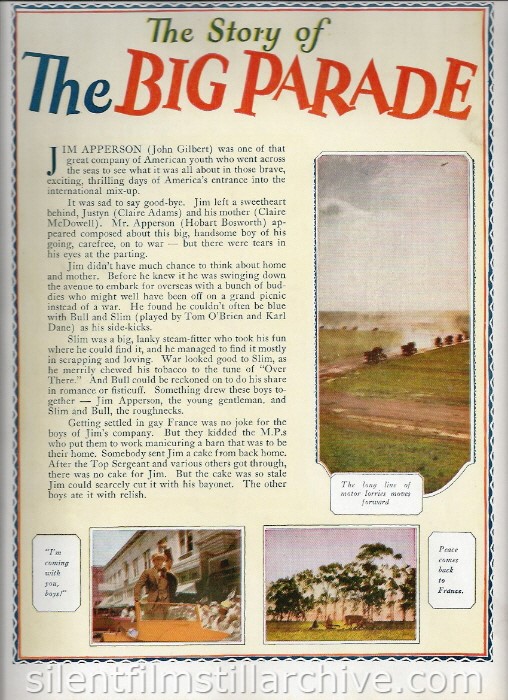
The Story of The BIG PARADE
JIM APPERSON (John Gilbert) was one of that great company of american youth who went across the seas to see what it was all about in those brave, exciting, thrilling days of America's entrance into the international mix-up.
It was sad to say good-bye. Jim left a sweetheart behind, Justyn (Claire Adams) and his mother (Claire McDowell). Mr. Apperson (Hobart Bosworth) appeared composed about this big, handsome boy of his going, carefree, on to war -- but there were tears in his eyes at the parting.
Jim didn't have much chance to think about home and mother. Before he knew it he was swinging down the avenue to embark for overseas with a bunch of buddies who might well have been off on a grand picnic instead of a war. He found he couldn't often be blue with Bull and Slim (played by Tom O'Brien and Karl Dane) as his side-kicks.
Slim was a big, lanky steam-fitter who took his fun where he could find it, and he managed to find it mostly in scrapping and loving. war looked good to Slim, as he marrily chewed his tobacco to the tune of "Over There." And bull could b ereckoned on to do his share in romance or fisticuff. Something drew these boys together -- Jim Apperson, the young gentleman, and Slim and Bull, the roughnecks.
Getting settled in gay France was no joke for the boys of Jim's company. But they kidded the M.P.s who put them to work manicuring a barn that was to be their home. Somebody sent Jim a cake from back home. After the Top Sergeant and various others got through, there was no cake for Jim. But the cake was so stale Jim could scarcely cut it with his bayonet. The other boys ate it with relish.
The long line of motor lorries moves forward.
"I'm coming with you, boys!"
Peace comes back to France.
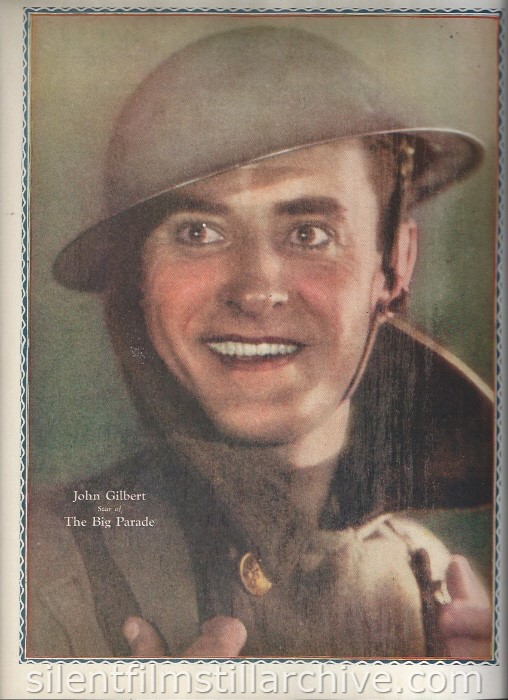
John Gilbert star of The Big Parade
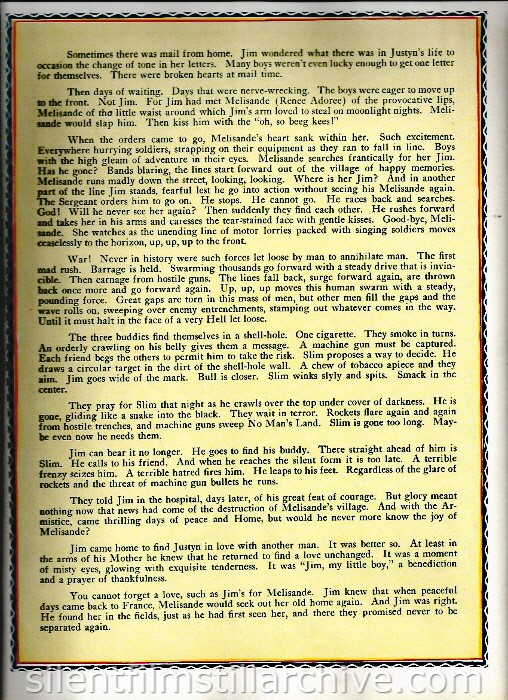
Sometimes there was mail from home. Jim wondered what there was in Justyn's life to occasion the change of tone in her letters. many boys weren't even lucky enough to get one letter for themselves. There were broken hearts at mail time.
Then days of waiting. Days that were nerve-wrecking. The boys were eager to move up to the front. Not Jim. for Jim had met Melisande (Renee Adoree) of the provocative lips, Melisande of the little waist around which Jim's arm loved to steal on moonlight nights. Melisande would slap him. Then kiss him with the "oh, so beeg kees!"
When the orders came to go, Melisande's heart sank within her. Such excitement. Everywhere hurrying soldiers, strapping on their equipment as they ran to fall in line. Boys with the high gleam of adventure in their eyes. Melisande searches frantically for her Jim. Has he gone? Bands blaring, the lines start forward out of the village of happy memories. Melisande runs madly down the street, looking, looking. Where is her Jim? And in another part of the line Jim stands, fearful lest he go into action without seeing his Melisande again. The Sergeant orders him to go on. He stops. he cannot go. He races back and searches. God! Will he never see her again? Then suddenly they find each other. he rushes forward and takes her in his arms and caresses the tear-stained face with gentle kisses. Good-bye, Melisande. She watches as the unending line of motor lorries packed with singing soldiers moves ceaselessly to the horizon, up, up, up to the front.
War! Never in history were such forces let loose by man to annihilate man. The first mad rush. Barrage is held. Swarming thousands go forward with a steady drive that is invincible. Then carnage from hostile guns. The lines fall back, surge forward again, are thrown back once more and go forward again. Up, up, up moves this human swarm with a steady, pounding force. Great gaps are town in this mass of men, but other men fill the gaps and the wave rolls on, sweeping over enemy entrenchments, stamping out whatever comes in the way. Until it must halt in the face of a very Hell let loose.
The three buddies find themselves in a shell-hole. One cigarette. They smoke in turns. An orderly crawling on his belly gives them a message. A machine gun must be captured. Each friend begs the others to permit him to take the risk. Slim proposes a way to decide. He draws a circular target in the dirt of the shell-hole wall. A chew of tobacco apiece and they aim. Jim goes wide of the mark. Bull is closer. Slim winks slyly and spits. Smack in the center.
They pray for Slim that night as he crawls over the top under cover of darkness. He is gone, gliding like a snake into the black. They wait in terror. Rockets flare again and again from hostile trenches, and machine guns sweep No Man's Land. Slim is gone too long. Maybe even now he needs them.
Jim can bear it no longer. He goes to find his buddy. there straight ahead of him is Slim. He calls to his friend. And when he reaches the silent form it is too late. A terrible frenzy seizes him. A terrible hatred fires him. he leaps to his feet. Regardless of the glare of rockets and the threat of machine gun bullets he runs.
They told Jim in the hospital, days later. of his great feat of courage. But glory meant nothing now that news had come of the destruction of Melisande's village. And with the Armistace, came thrillings days of peace and Home, but would he never more know the joy of Melisande?
Jim came home to find Justyn in love with another man. It was better so. At least in the arms of his Mother he knew that he return to find a love unchanged. it was a moment of misty eyes, glowing with exquisite tenderness. it was "Jim, my little boy," a benediction and aprayer of thenkfulness.
You cannot forget a love, such as Jim's for Melisande. Jim knew that when peaceful days came back to France, Melisande would seek out her old home again. And Jim was rignt. he found her in the fields, just as he had first seen her, and there they promised never to be separated again.
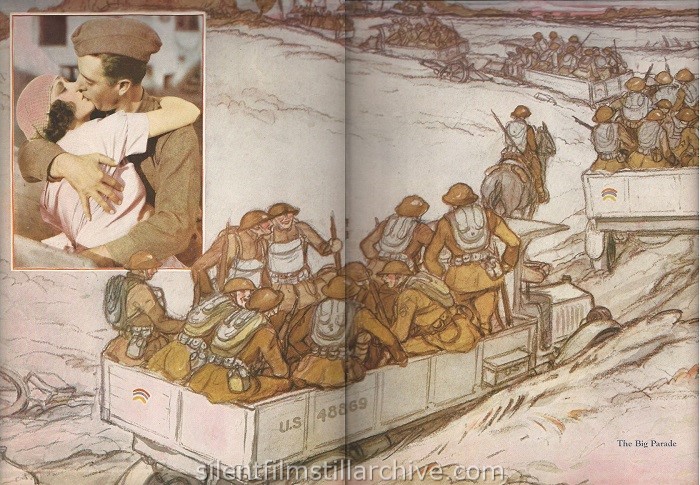
The Big Parade
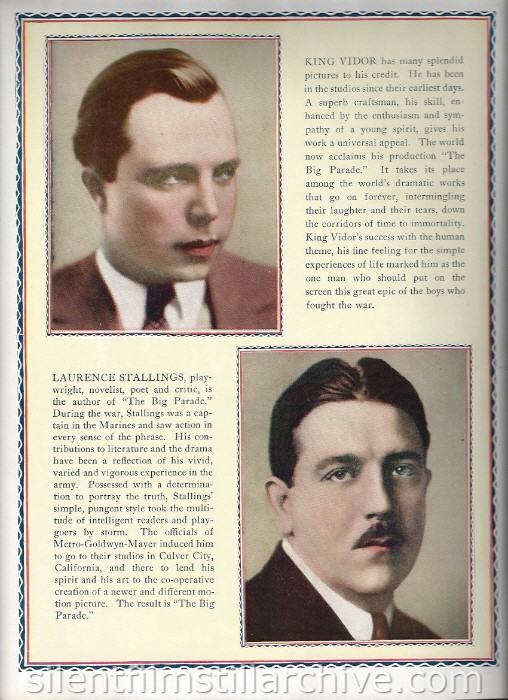
KING VIDOR has many splendid pictures to his credit. He has been in the studios since their earliest days. A superb craftsman, his skill, enhanced by the enthusiasm and sympathy of a young spirit, gives his work a universal appeal. The world now acclaims his production "The Big Parade." It takes its place amoung the world's dramatic works that go on forever, intermingling their laughter and their tears, down the corridors of time to immortality. King Vidor's success with the human theme, his fine feeling for the simple experiences of life marked him as the one man who should put on the screen this great epic of the boys who fought the war.
LAURENCE STALLINGS, playwright, novelist, poet and critic, is the author of "The Big Parade." During the war, Stallings was a captain in the marines and saw action in every sense of the phrase. His contributions to literature and the drama have been a reflection of his vivid, varied and vigorous experience in the army. Possessed with a determination to portray the truth, stallings' simple, pungent style took the multitude of intelligent readers and playgoers by storm. The officials of Metro-Goldwyn-Mayer induced him to go to their studios in Culver City, California, and there to lend his spirit and his art to the co-operative creation of a newer and different motion picture. The result is "The Big Parade."
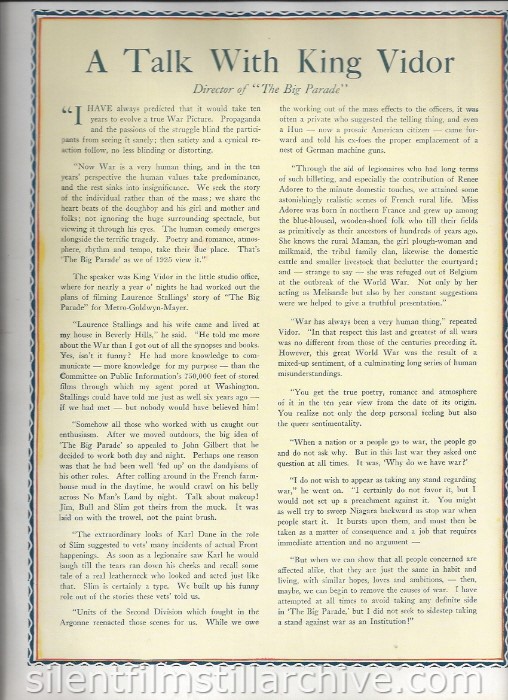
A Talk with King Vidor
Director of "The Big Parade"
"I HAVE always predicted that it would take ten years to evolve a true War Picture. Propaganda and the passions of the struggle blind the participants from seeing it sanely; then satiety and a cynical reaction follow, no less blinding or distorting.
"Now War is a very human thing, and in the ten years' perspective the human values take predominance, and the rest sinks into insignificance. We seek the story of the individual rather than the mass; we share the heart beats of the doughboy and his girl and mother and olks; not ignoring the huge surrounding spectacle, but viewing it through his eyes. The human comedy emerges alongside the terrific tragedy. Poetry and romance, atmosphere, rhythm and tempo, take their due place. That's 'The Big Parade' as we of 1925 view it."
The speaker was King Vidor in the little studio office, where for nearly a year o' nights he had worked out the plans of filming Laurence Stallings' story of "The Big Parade" for Metro-Goldwyn-Mayer.
"Laurence Stallings and his wife came and lived at my house in Beverly Hills," he said. "He told me more about the War than I got out of all the synopses and books. yes, isn't it funny? He had more knowledge to communicate -- more knowledge for my purpose -- than the Committee on Public Information's 750,000 feet of stored films through which my agent pored at Washington. Stallings could have told me just as well six years ago -- if we had met -- but nobody would have believed him!
"Somehow all those who worked with us caught our enthusiasm. After we moved outdoors, the big idea of 'The Big Parade' so appealed to John Gilbert that he decided to work both day and night. perhaps one reason was that he had been well 'fed up' on the dandyisms of his other roles. After rolling around in the French farmhouse mud in the daytime, he would crawl on his belly across No Man's Land by night. Talk about makeup! Jim, Bull and Slim got theirs fromt he muck. it was laid on with the trowel, not the paint brush.
"The extraordinary looks of Karl Dane in the role of Slim suggested to vets' many incidents of actual Front happenings. as soon as a legionaire saw Karl he would laugh till the tears ran down his cheeks and recall some tale of a real leatherneck who looked and actedjust like that. Slim is certainly a type. We built up his funny role out of the stories these vets' told us.
"Units of the Second Division which fought in the Argonne reenacted those scenes for us. While we owe the working out of the mass effects to the officers, it was often a private who suggested the telling thing, and even a Hun -- now a prosaic American citizen -- came forward and told his ex-foes the proper emplacement of a nest of German machine guns.
"Though the aid of legionaires who had long terms of such billeting, and especially the contribution of Renee Adoree to the minute domestic touches, we attained some astonishingly realistic scenes of French rural life. Miss Adoree was born in northern France and grew up among the blue-bloused, wodden-shoed folk who till their fields as primitively as their ancestors of hundreds of years ago. She knows the rural Maman, the girl plough-woman and milkmaid, the tribal family clan, likewise the domestic cattle and smaller livestock that beclutter the courtyard; and -- strange to say -- she was refuged out of Belgium at the outbreak of the World War. Not only by her acting as Melisande but also by her constant suggestions were we helped to give a truthful presentation."
"War has always been a very human thing," repeated Vidor. "In that respect this last and greatest of all wars was no different from those of the centuries preceding it. However, this great World war was the result of a mixed-up sentiment, of a culminating long series of human misunderstandings.
"You get the true poetry, romance and atmosphere of it in the ten year view from the date of its origin. You realize not only the deep personal feeling but also the queer sentimentality.
"When a nation or a people go to war, the people go and do not ask why. But in this last war they asked one question at all times. It was, 'Why do we have war?"
"I do not wish to appear as taking any stand regarding war," he went on. "I certainly do not favor it, but I would not set up a preachment against it. You might as well try to sweep Niagara backward as stop war when people start it. It bursts upon them, and must then be taken as a matter of consequence and a job that requires immediate attention and no argument--
"But when we can show that all people concerned are affected alike, that they are just the same in habit and living, with similar hopes, loves, and ambitions, -- then, maybe, we can begin to remove the causes of war. I have attempted at all times to avoid taking any definite side in 'The Big Parade,' but I did not seek to sidestep taking a stand against war as an institution!'
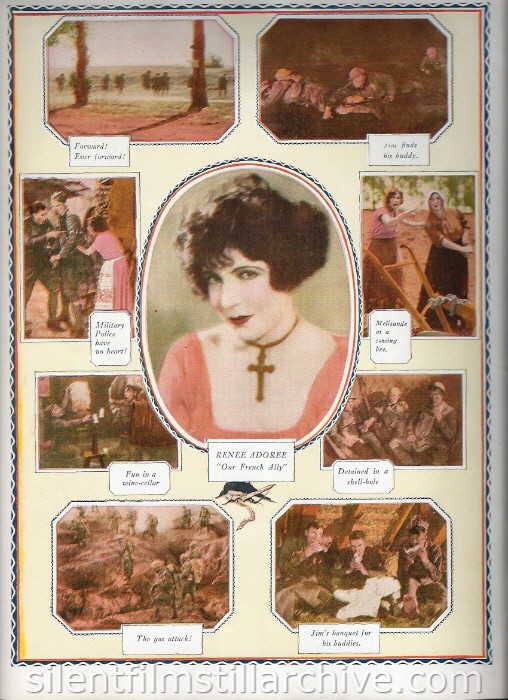
Forward! Ever forward! Jim finds his buddy.
Military Police have no heart! Melisande at a sowing bee.
Fun in a wine cellar Detained in a shell-hole
RENEE ADOREE "Our French Ally"
The gas attack! Jim's banquet for his buddies
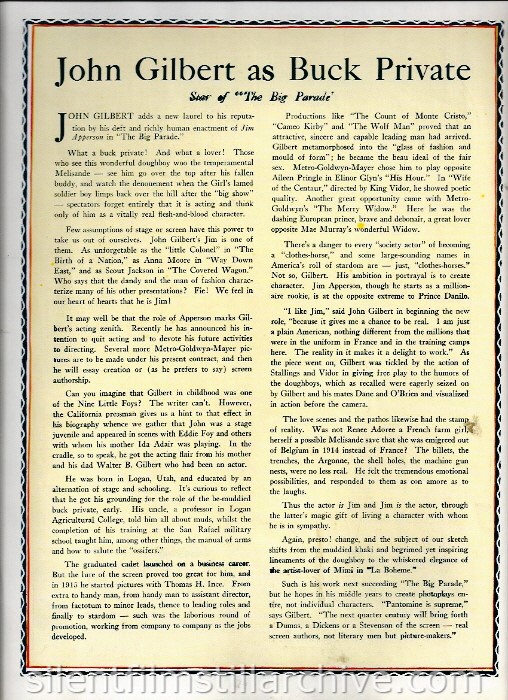
John Gilbert as Buck Private
Star of "The Big Parade"
JOHN GILBERT adds a new laurel to his reputation by his deft and richly human enactment of Jim Apperson in "The Big Parade."
What a buck private! And what a lover! Those who see this wonderful doughboy woo the temperamental Melisande -- see him go over the top after his fallen buddy, and watch the denouement when the Girl's lamed soldier boy limps back over the hill after the "big show" -- spectators forget entirely that it is acting and think only of him as a vitally real flesh-and-blood character.
Few assumptions of stage or screen have this power to take us out of ourselves. John Gilbert's Jim is one of them. As unforgetable as the "little Colonel" in "The Birth of a Nation", as Anna Moore in "Way Down East," and as Scout jackson in "The Covered Wagon." Who says that the dandy and the man of fashion characterize man of his other presentations? Fie! We feel in our heart of hearts that he is Jim!
It may well be that the role of Apperson marks Gilbert's acting zenith. Recently he has announced his intention to quit acting and devote his future activities to directing. Several more Metro-Goldwyn-Mayer pictrues are to be mad under his present contract, and then he will essay creation or (as he prefers to say) screen authorship.
Can you imagine that Gilbert in childhood was one of the Nine Little Foys? The writer can't. However, the California pressman gives us a hint to that effect in his biography whence we gather that John was a stage juvenile and appeared in scenes with Eddie Foy and others with whom his mother Ida Adair was plahing. In the credle, so to speak, he got the acting flair from his mother and his did Walter B. Gilbert who had been an actor.
He was born in Logan, Utah, and educated by an alternation of stage and schooling. It's courious to reflect that he got his grounding for the role of the be-muddled buck private, early. His uncle, a professor in Logan Agricultural College, told him all about muds, whilst the completion of his training at the San Rafael military school taught him, amond other things, the manual of arms and how to salute the "ossifers."
The graduated cadet launched on a business career. But the lure of the screen proved too great for him, and in 1915 he started in picture with Thomas H. Ince. From extra to handy man, from handy man to assistant director, from factotum to minor leads, thence to leading roles and finally to stardom -- such was the laborious round of promotion, working from company to company as the jobs developed.
Productions like "The Count of Monte Cristo," "Cameo Kirby" and "The Wolf Man" proved thatan attractive, sincere and capable leading man had arrived. Gilbert metamorphosed into the "glass of fashion and mould of form"; he became the beau ideal of the fair sex. Metro-Goldwyn-Mayer chose him to play opposite Aileen Pringle in Elinor Glyn's "His Hour." In "Wife of the Centaur," directed by King Vidor, he showe poetic quality. Another great opportunity came with Metro-Goldwin's "The Merry Widow." Here he was the dashing European prince, brave and debonair, a great lover opposite Mae Murray's wonderful Widow.
There's a danger to every "society actor" of becoming a "clothes-horse," and some large-sounding names in America's roll of stardom are -- just, "clothes-horses." Not so, Gilbert. his ambition in portrayal is to create character. Jim Apperson, though he starts as a millionaire rookie, is at the opposite extreme to prince Danilo.
"I like Jim," said John Gilbert in beginning the new role, "because it gives me a chance to be real. I am just a plain American, nothingdifferent from the millions that were in the uniform in France and in the training camps here. The reality in it makes it a delight to work." As the piece went on, Gilbert was tickled by the action of Stallings and Vidor in giving free play to the humors of the doughboys, which as recalled were eagerly seized on by Gilbert and his mates Dane and O'Brien and visualized in action before the camera.
The love scenes and the pathos likewise had the samp of reality. Was not Renee Adoree a French farm girl, herself a possible Melisande sav that she was emigreed out of Belgium in 1914 instead of France? The billets, the tranches, the Argonne, the shell holes, the machine gun nests, were no less real. He felf that trmendous emotional possibilities, and responded to them as con amore as to the laughs.
Thus the actor is Jim and Jim is the actor, though the latter's magic gift of living a character with whom he is in sympathy.
Again, presto! change, and the subject of our sketch shifts from the muddied khaki and begrimed yet inspiring lineaments of the doughboy to the whiskered elegance of the artist-lover of Mimi in "La Boheme."
Such is his work next succeeding "The Big Parade," but he hopes in his middle years to create photoplay entire, not individual characters. "Pantomine is supreme," says Gilbert. "the next quarter century will bring forth a Dumas, a Dickens or a Stevenson of the screen -- real screen authors, not literary men but picture-makers."
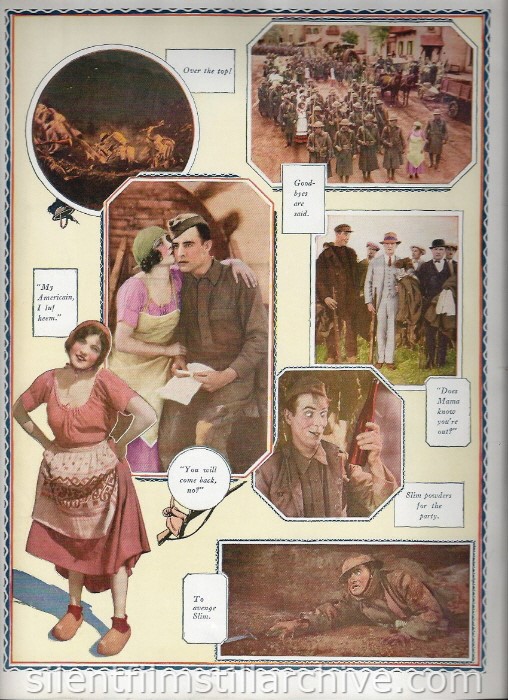
Over the top!
Good-byes are said.
"My Americain, I luf heem."
"You will come back, no?"
"Does Mama know you're out?"
Slim powders for the party.
To avenge Slim.
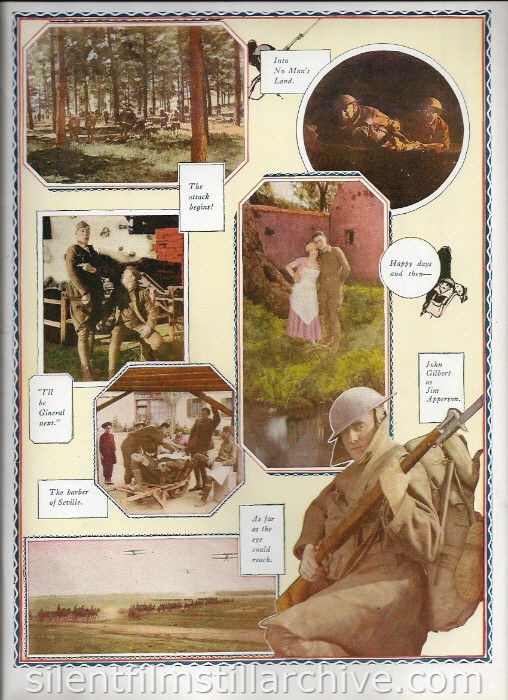
Into No Man's Land.
The attack begins!
"I'll be Gineral next."
The barber of Seville.
Happy days and then--
John Gilbert as Jim Apperson
As far as the eye could reach.
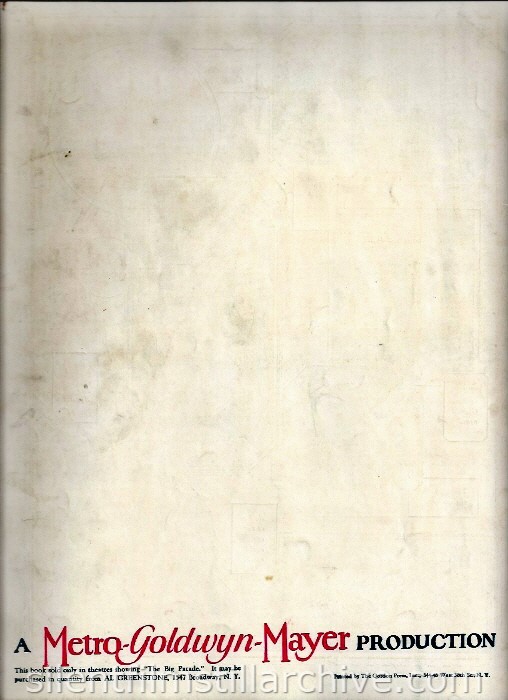
A Metro-Goldwyn-Mayer PRODUCTION
This book sold only in theatres showing "The Big Parade." It may be purchased in quantity from AL GREENSTONE, 1547 Broadway, N. Y.
Printed by The Gordon Press, Inc., 344-48 West 38th St., N. Y.
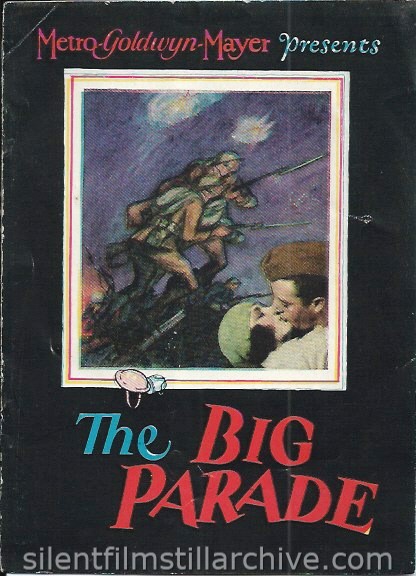
Metro-Goldwyn-Mayer presents
The BIG PARADE
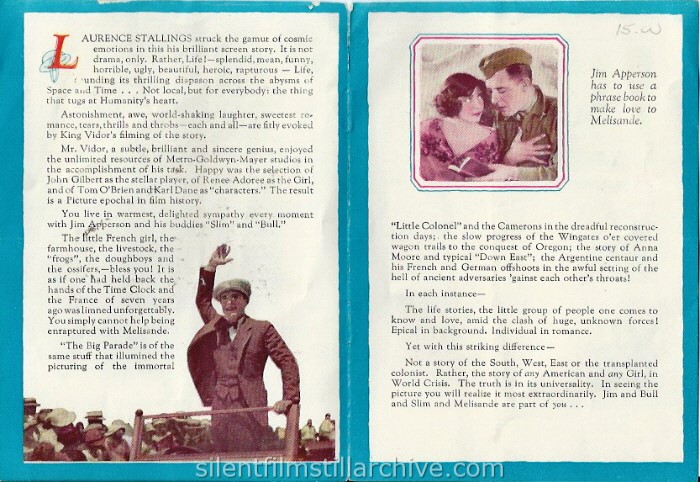
LAURENCE STALLINGS struck the gamut of coamic emotions in this his brilliant screen story. It is not drama, only. Rather, Life! -- splendid, mean, funny, horrible, ugly, beautiful, heroic, rapturous -- Life, sounding its thrilling diapason across the abysms of Space and Time ... Not local, but for everybody; the thing that tugs at Humanity's heart.
Astonishment, awe, world-shaking laughter, sweetest romance, tears, thrills and throbs -- each and all -- are fitly evoked by king Vidor's filming of the story.
Mr. Vidor, a subtle, brilliant and sincere genius, enjoyed the unlimited resources of Metro-Goldwyn-Mayer studios in the accomplishment of his task. happy was the selection of john Gilbert as the stellar player, of Renee Adoree as the Girl, and of Tom O'Brien and Karl Dane as "characters." The result is a picture epochal in film history.
You live in warmest, delighted sympathy every moment with Jim apperson and his buddies "Slim" and "Bull".
The little French girl, the farmhouse, the livestock, the "frogs", the doughboys and the ossifers, -- bless you! It is as if one had held back the hands of the Time Clock and the France of seven years ago was limned unforgettably. You simply cannot help being enraptured with Melisande.
"The Big Parade" is of the same stuff that illumined the picturing of the immortal "Little Colonel" and the Camerons in the dreadful reconstruction days; the slow progress of the Wingates o'er covered wagon trails to the conquest of Oregon; the story of Anna Moore and typical "Down East"; the Argetine cantaur and his French and German offshoots in the awful setting of the hell of ancient adversaries 'gainst each other's throats!
In each instance --
The life stories, the little group of people one comes to know and love, amid the clash of huge, unknown forces! Epical in background. Individual in romance.
Yet with this striking difference --
Not a story of the South, West, East or the transplanted colonist. Rather the story of any American and any Girl, in World Crisis. the truth is in its universality. In seeing the picture you will realize it most extraordinarily. Jim and Bull and Slim and Melisande are part of you.
Jim Apperson has to use a phrase book to make love to Melisande.
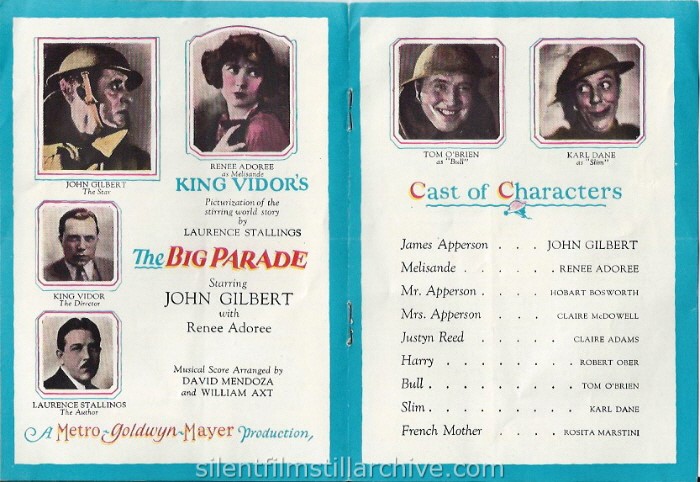
JOHN GILBERT The Star
RENEE ADOREE as Melisande
KIND VIDOR The Director
LAURENCE STALLINGS The Author
TOM O'BRIEN as "Bull"
KARL DANE as "Slim"
KING VIDOR'S
Picturization of the stirring world story by
LAURENCE STALLINGS
The BIG PARADE
Starring
JOHN GILBERT
with Renee Adoree
Musical Score Arranged by DAVID MENDOZA and WILLIAM AXT
A Metro-Goldwyn-Mayer Production
Cast of Characters
|
James Apperson |
JOHN GILBERT |
|
Melisande |
RENEE ADOREE |
|
Mr. Apperson |
HOBART BOSWORTH |
|
Mrs. Apperson |
CLAIRE McDOWELL |
|
Justyn Reed |
CLAIRE ADAMS |
|
Harry |
ROBERT OBER |
|
Bull |
TOM O'BRIEN |
|
Slim |
KARL DANE |
|
French Mother |
ROSITA MARSTINI |
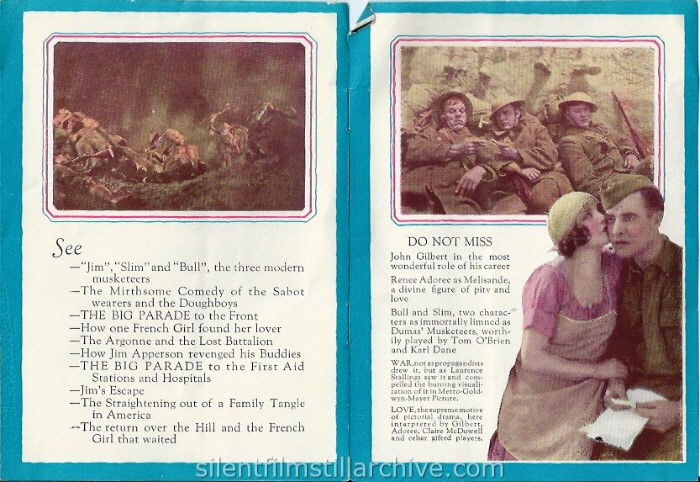 See
See
-- "Jim", "Slim" and "Bull", the three modern musketeers
-- The Mirthsome Comedy of the Sabot wearers and the Doughboys
-- THE BIG PARADE to the Front
-- How one French Girl found her lover
-- The Argonne and the Lost Battalion
-- How Jim Apperson revenged his Buddies
-- THE BIG PARADE to the First Aid Stations and Hospitals
-- Jim's Escape
-- The Straightening out of a Family Tangle in America
-- The return over the Hill and the French Girl that waited
DO NOT MISS
John Gilbert in the most wonderful role of his career
Renee Adoree as Melisande, a divine figure of pity and love
Bull and Slim, two characters as immortally limned as Dumas' Musketeers, worthily played by Tom O'Brien and Karl Dane
WAR, not as propagandists drew it, but as Laurence Stallings saw it and compelled the burning visualization of it in Metro-Goldwyn-Mayers Picture.
LOVE, the supreme motive of pictorial drama, here interpreted by Gilbert, Adoree, Claire McDowell and other gifted players.
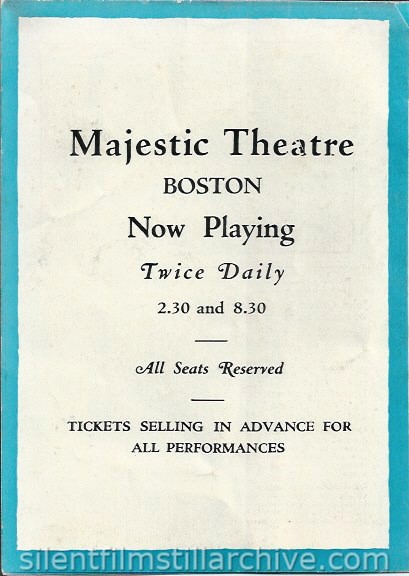
Majestic Theatre
BOSTON
Now Playing
Twice Daily
2.30 and 8.30
All Seats Reserved
TICKETS SELLING IN ADVANCE FOR ALL PERFORMANCES
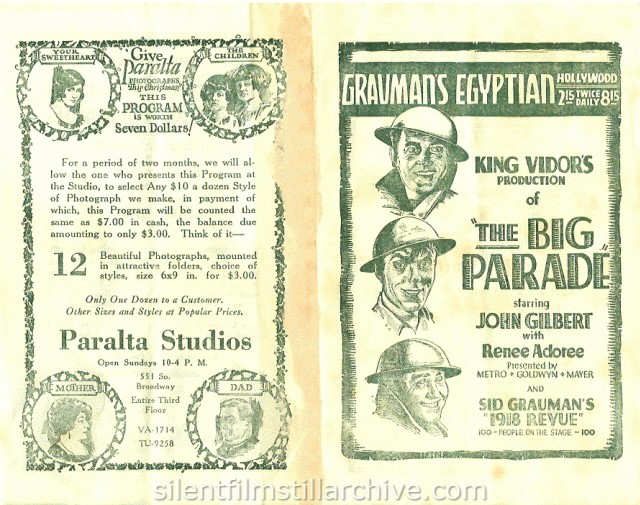
Grauman's Egyptian Hollywood
Twice Daily 2:15 8:15
King Vidor's production of
THE BIG PARADE
starring John Gilbert with Renee Adoree
Presented by Metro Goldwyn Mayer
and
Sid Grauman's "1918" Revue
100 -- People on the Stage -- 100
(Paralta Studios Ad on the back page)
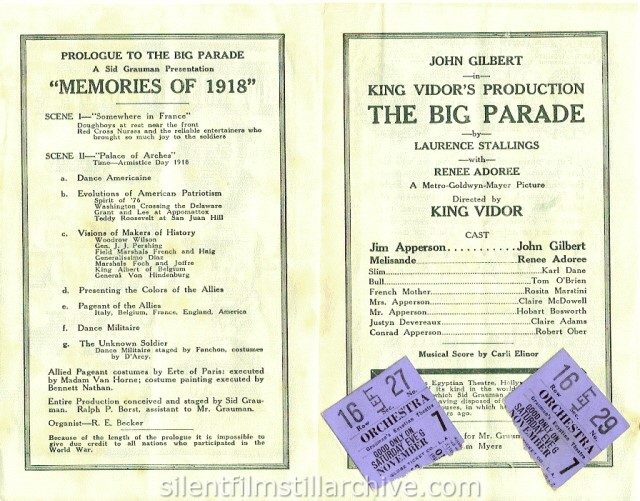
Prologue to the BIG PARADE
A Sid Grauman Presentation
"MEMORIES OF 1918"
SCENE 1 -- "Somewhere in France"
Doughboys at rest near the front
Red Cross Nurses and the reliable entertainers who brought so much joy to
the soldiers
SCENE 2 -- "Palace of Arches"
Time - Armistice Day 1918
a. Dance Americaine
b. Evolutions of American Patriotism
Spirit of '76
Washington Crossing the Delaware
Grant and Lee at Appomattox
Teddy Roosevelt at San Juan Hillc. Visions of Makers of History
Woodrow Wilson
Gen. J. J. Pershing
Field Marshals French and Haig
Generalissimo Diaz
Marshals Foch and Joffre
King Albert of Belgium
General Von Hindenburgd. Presenting the Colors of the Allies
e. Pageant of the Allies
Italy, Belgium, France, England, America
f. Dance Militaire
g. The Unknown Soldier
Dance Militaire staged by Fanchon, costumes by D'Arcy
Allied Pageant costumes by Erte of Paris; executed by Madame Van Horne; costume painting executed by Bennett Nathan.
Entire production concieved and staged by Sid Grauman. Ralph P. Borst, assistant to Mr. Grauman.
Organist -- R. E. Becker
Because of the length of the prologue it is impossible to give due credit to all nations who participated in the World War.
JOHN GILBERT in
KING VIDOR'S PRODUCTION
THE BIG PARADE
by LAURENCE STALLINGS
with RENEE ADOREE
A Metro Goldwyn Mayer Picture
Directed by KING VIDOR
CAST
|
Jim Apperson |
John Gilbert |
|
Melisande |
Renee Adoree |
|
Slim |
Karl Dane |
|
Bull |
Tom O'Brien |
|
French Mother |
Rosita Marstini |
|
Mrs. Apperson |
Claire McDowell |
|
Mr. Apperson |
Hobart Bosworth |
|
Justyn Devereaux |
Claire Adams |
|
Conrad Apperson |
Robert Ober |
Musical Score by Carli Elinor
Manager for Mr. Grauman
Sam Meyers
This program came from a scrapbook and has two ticket stubs attached from the Saturday, November 7, 1925 screening. The seats were row 16 Left, seats 27 and 29.
with John Gilbert, Renée Adorée, and Karl Dane. Directed by King Vidor. Metro-Goldwyn-Mayer.
More Information on this film...
Books
King Vidor, American, by Raymond Durgnat, pp. 61-72
A Tree is a Tree, by King Vidor, chapter 11.
The War, The West, and the Wilderness, by Kevin Brownlow, pp. 184-194
More Information on the Majestic Theatre...
The Majestic Theatre at CinemaTreasures.com
More Information on the Grauman's Egyptian Theatre...
The Egyptian Theatre at CinemaTreasures.com
Last Modified January 12, 2024



















